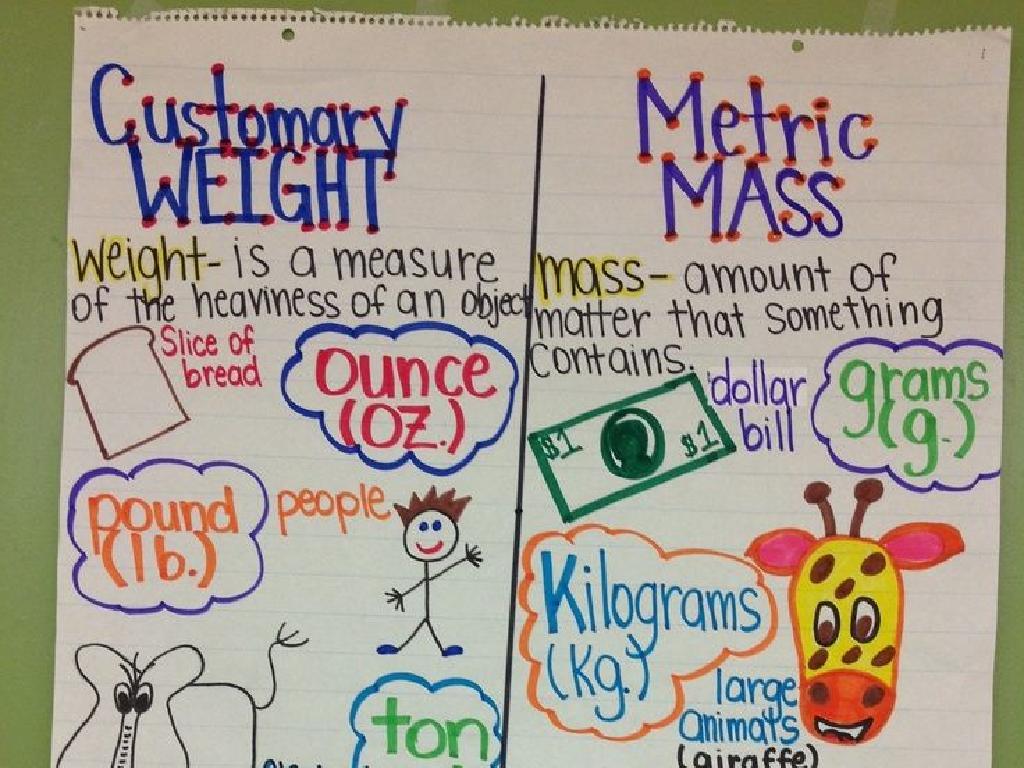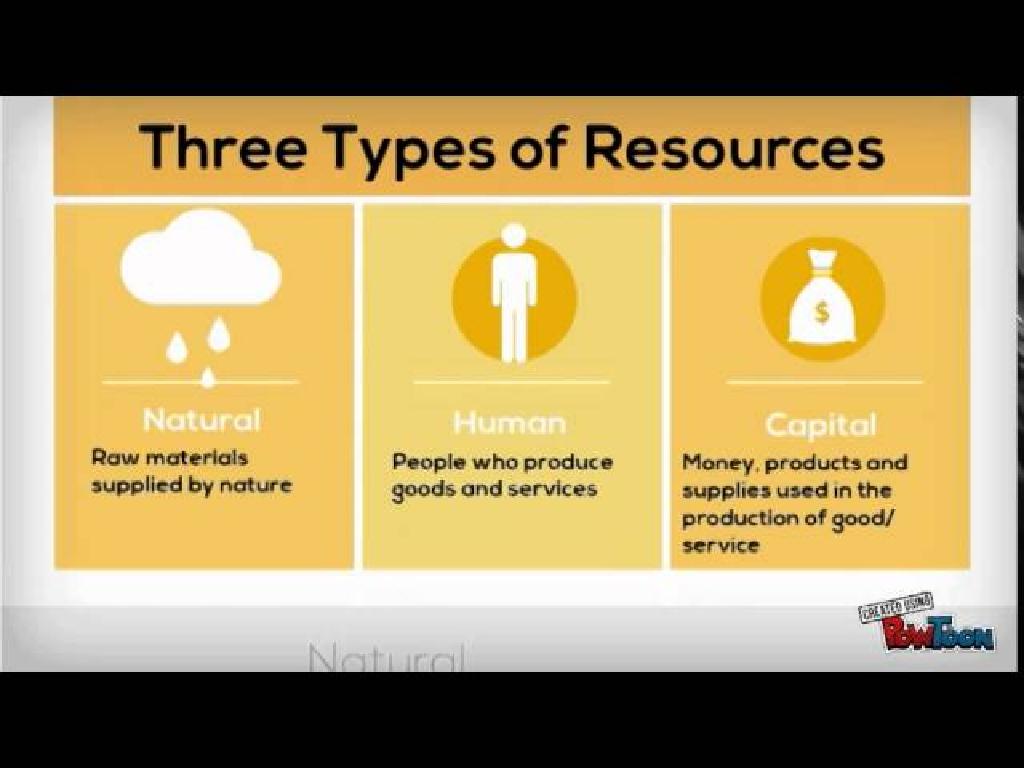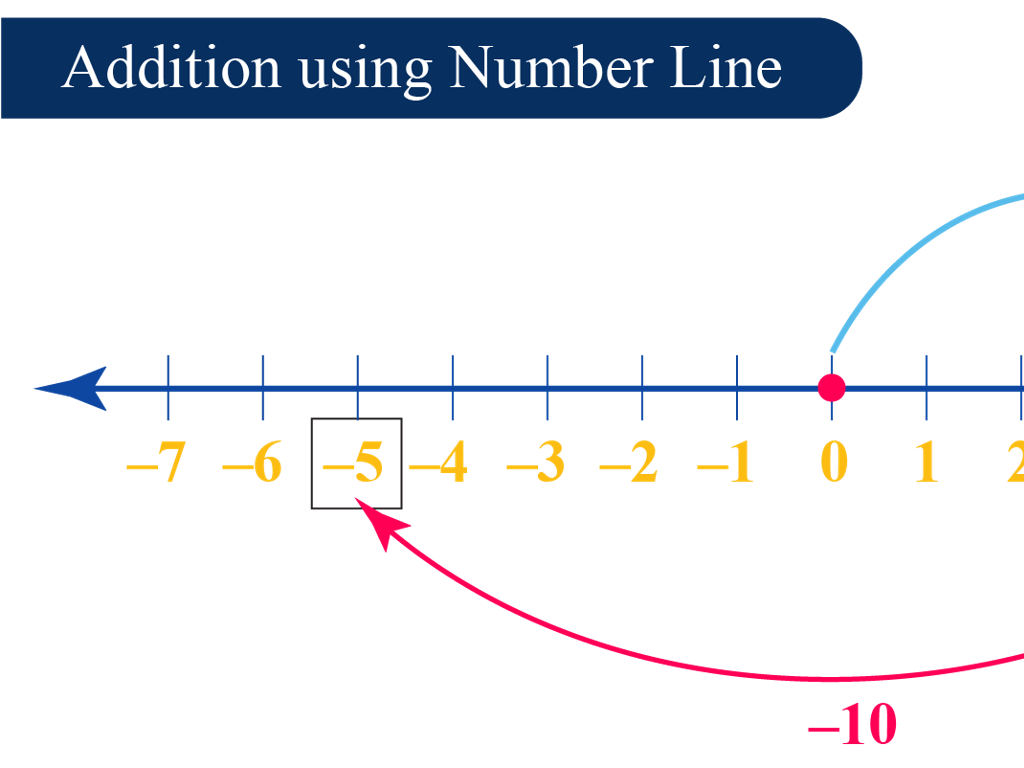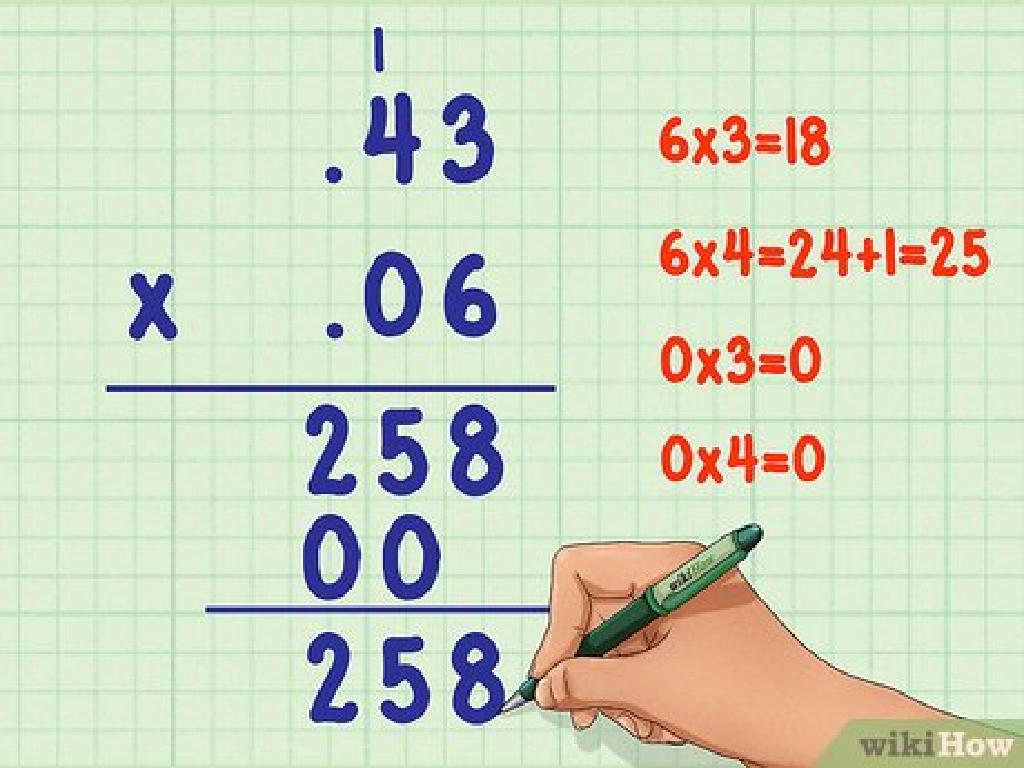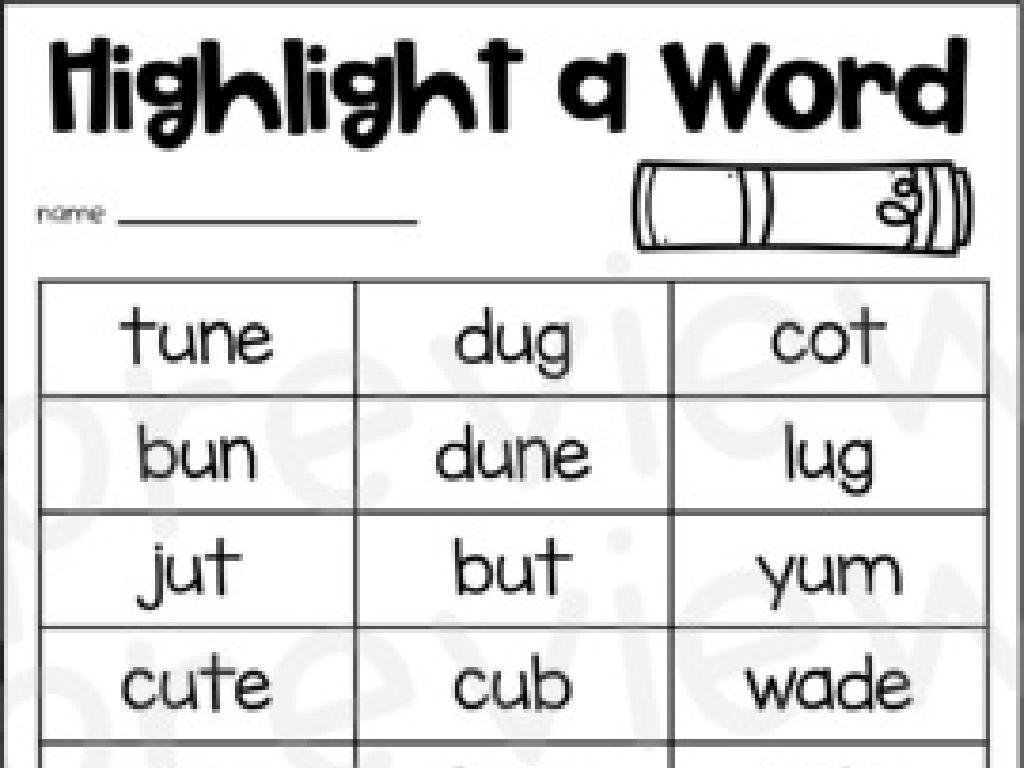Place Value Models
Subject: Math
Grade: Fourth grade
Topic: Place Value
Please LOG IN to download the presentation. Access is available to registered users only.
View More Content
Welcome to Place Values!
– Grasping place value importance
– Place value determines a digit’s value based on its position.
– Place value in daily math
– Helps with shopping, telling time, and handling money.
– Exploring place value models
– Visual models show the value of each digit in a number.
– Engaging with hands-on activities
– We’ll use blocks and charts to learn about place values.
|
This slide introduces the concept of place value, which is fundamental to understanding numbers and how they work in mathematics. Emphasize the importance of each digit’s position in determining its value. Illustrate how place value is used in everyday situations like shopping or managing time and money. Preview the use of place value models such as base-ten blocks or place value charts, which will be used in today’s lesson to provide a visual and tactile way for students to comprehend the concept. Prepare several hands-on activities where students can manipulate these models to build numbers and see how changing the position of a digit changes its value.
Understanding Place Value
– What is place value?
– It’s the value of where a digit is in a number.
– Position matters in numbers
– Each spot in a number has a different value.
– Examples using place value
– 30 in 34 has a different value than 3 in 43.
|
This slide introduces the concept of place value, which is fundamental in understanding how numbers are structured and how their value changes with position. Emphasize that in multi-digit numbers, the position of each digit is crucial because it determines the digit’s value. Use clear examples to show that the same digit can represent different amounts depending on where it’s placed in a number. For instance, the ‘3’ in ‘300’ represents three hundred, but in ’23’, it represents three. Encourage students to think of numbers as made up of ‘places’ or ‘spots’, and each spot has a value that is ten times the spot to its right.
Building Blocks of Place Value
– Learn with Base-Ten Blocks
– Base-Ten Blocks represent ones, tens, hundreds.
– Each Block’s Place Value
– A single block is a ‘one’, a rod is ‘ten’, a flat is ‘hundred’.
– Hands-on: Build with Blocks
– Use blocks to construct different numbers.
– Understanding Numbers
|
This slide introduces students to the concept of place value using Base-Ten Blocks, a visual and tactile method. Each type of block corresponds to a different place value, which helps students visualize and understand the size of numbers. The hands-on activity involves students using these blocks to build and deconstruct numbers, reinforcing their understanding of how place value works. Encourage students to explain their thought process as they build each number to ensure comprehension. Provide examples of different numbers for students to build and then discuss as a class.
Place Value Models: Visualizing Numbers
– Visualize numbers using models
– Use blocks or circles to represent ones, tens, hundreds
– Steps to draw place value models
– Draw a chart, place ones, tens, hundreds in columns
– Class activity: create your own models
– Each student draws models for numbers I assign
|
This slide introduces students to the concept of place value models, which are visual tools to help understand the value of digits in different places in a number. Start by explaining that each place in a number has a different value (ones, tens, hundreds, etc.) and can be represented with blocks or circles. Demonstrate how to draw a simple chart with columns for each place value and how to place the correct number of blocks or circles in each column. For the class activity, assign different numbers to each student and have them draw the corresponding place value models. Possible variations for the activity could include using different items like stickers or stamps to represent the different place values, or creating a place value collage with images from magazines.
Understanding Larger Numbers
– Break down numbers into place values
– Thousands, hundreds, tens, and ones
– Read and write large numbers
– Use commas for clarity: 5,678
– Practice identifying place values
– Which digit is in the tens place in 3,827?
– Grasp the concept of thousands
– Understand that ‘thousands’ is a big group of ten ‘hundreds’
|
This slide aims to help students understand the concept of place value for larger numbers. Start by explaining how to break down a number into thousands, hundreds, tens, and ones. Demonstrate reading and writing large numbers, emphasizing the use of commas to separate place values for clarity. Engage students with practice exercises to identify the place value of digits in large numbers. Highlight the significance of the ‘thousands’ place as a key milestone in place value comprehension. Provide examples and encourage students to work through problems both individually and in groups to reinforce their understanding.
Place Value in Real Life
– Place value in shopping
– When shopping, each digit in a price has a different value.
– Understanding prices
– Prices show how much money items cost using place value.
– Analyzing bills for place value
– Look at a bill and see how place value organizes the amounts.
– Group discussion activity
|
This slide aims to help students understand the practical application of place value in everyday life, such as when shopping. Explain that each position of a number in a price tag represents a different value (e.g., in $12.34, the ‘1’ is in the tens place). Use real-life examples like grocery bills to show how place value helps us understand the cost of items and total amounts. Encourage a group discussion where students find and discuss the place values in numbers they encounter in real life, such as on receipts or in advertisements. This will reinforce their understanding of place value and its importance in daily activities.
Let’s Play a Place Value Game!
– Race to build the highest number
– Play the game in pairs
– Share strategies after playing
– Did you use larger digits in higher places?
– Discuss what we learned
– How did place value help you win?
|
This interactive game is designed to reinforce the concept of place value. Students will pair up and compete to create the highest number possible using digit cards. After the game, they will come together to discuss the strategies they used, such as placing larger digits in the tens or hundreds place. Encourage students to reflect on how understanding place value helped them during the game. This activity not only solidifies their grasp of place value but also promotes critical thinking and collaboration. Possible variations of the game could include using dice to generate numbers or challenging students to make the smallest number possible.
Class Activity: Place Value Art
– Create art using numbers
– Use paper, pencils, & base-ten blocks
– Understand place values through art
– Combine digits creatively to represent place values visually
– Present your artwork to the class
– Explain how your art represents different place values
|
This activity is designed to help students understand place value concepts in a fun and creative way. Provide each student with paper, pencils, and a set of base-ten blocks. Students will use the materials to create a piece of art that incorporates numbers and their place values. For example, they could draw a house with the number of windows representing ones, the number of doors representing tens, and so on. After completing their artwork, each student will present their creation to the class and explain how they used place value in their design. This will reinforce their understanding of place values and allow for a creative expression of mathematical concepts. Possible variations of the activity could include creating place value cities, animals, or even self-portraits using numbers and base-ten blocks.
Place Value Review & Daily Applications
– Recap place value concepts
– Review ones, tens, hundreds, and so on.
– Place value in everyday life
– Use in shopping, organizing, and time management.
– Q&A session on place value
– Share your questions and let’s find answers together.
|
This slide aims to consolidate the students’ understanding of place value concepts covered in today’s lesson. Begin with a brief review of the base-ten system, emphasizing the value of each digit depending on its position. Then, discuss practical applications of place value, such as understanding money while shopping, organizing items in groups, or even planning activities according to time. The Q&A session will provide an opportunity for students to clarify any doubts and reinforce their knowledge. Encourage students to think of questions beforehand and ensure they understand how place value is not just a math concept but a tool used in various aspects of daily life.
Place Value Homework and Reminders
– Practice with Place Value Models
– Use the worksheet to draw models representing numbers.
– Solve Place Value Story Problems
– Complete the story problems using place value knowledge.
– Show and Tell: Place Value Art
– Prepare to present your place value art project in class.
– Remember to bring your artwork!
|
This slide outlines the homework assignment and reminders for the students. They are to practice drawing place value models using the provided worksheet, which will help reinforce their understanding of how numbers are composed of different place values. Additionally, they must solve story problems that incorporate place value concepts, further applying what they’ve learned in a practical context. Lastly, students are reminded to bring in their place value art, a creative project that allows them to express their understanding of place value visually. This activity is designed to cater to different learning styles and to make learning about place value engaging and hands-on. The teacher should ensure that students are clear on the expectations for their homework and the show and tell activity, and provide any necessary materials or support.

